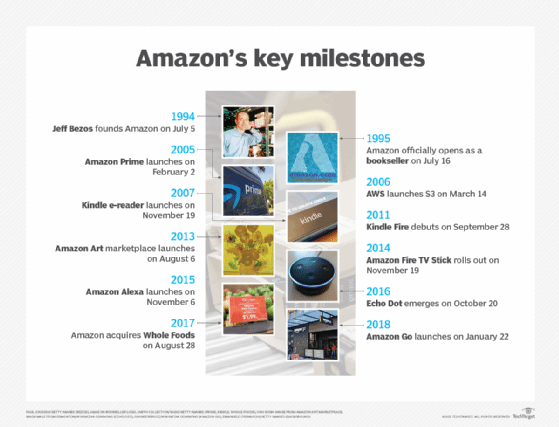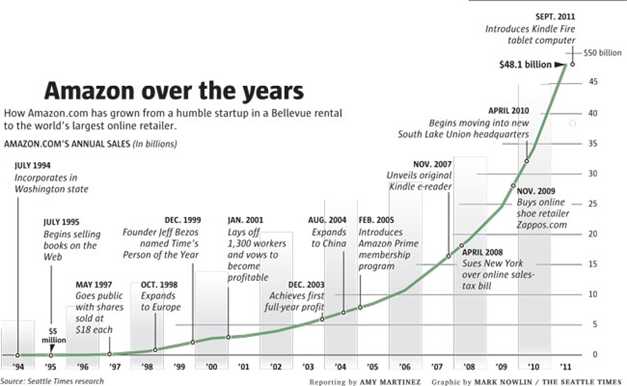
Introduction
Amazon, founded in 1994 by Jeff Bezos, has transformed from a humble online bookstore into one of the most powerful and multifaceted companies in the world. With a mission to be “Earth’s most customer-centric company,” Amazon has fundamentally changed how we shop, consume media, and even conduct business. This article delves deep into the company’s history, its diverse business model, innovations, challenges, and future outlook, illustrating the extensive impact Amazon has had on global commerce and technology The Evolution and Impact of Amazon: A Comprehensive Overview .
A Brief History

The Early Years (1994-2000)

Amazon’s journey began in Jeff Bezos’s garage in Seattle, where he envisioned an online marketplace that could offer customers a broader selection of books than any physical bookstore. The choice to start with books was strategic; the vast catalog available allowed for easy entry into the e-commerce space. On July 5, 1995, Amazon.com went live, quickly capturing attention with its user-friendly interface and innovative features.
Within just a month, Amazon sold books to customers in all 50 states and 45 countries, setting the stage for rapid growth. By 1997, Amazon had gone public, raising $54 million in its initial public offering (IPO). This influx of capital allowed the company to invest heavily in infrastructure and technology, laying the groundwork for its future expansion.
The Dot-Com Bubble and Survival (2000-2005)
The early 2000s marked a tumultuous period for many tech companies, with the burst of the dot-com bubble leading to significant declines in stock prices and closures. Amazon, however, managed to not only survive but also adapt. The company focused on improving its operational efficiency and reducing costs. For instance, it refined its logistics and fulfillment strategies, optimizing inventory management and shipping processes.
In 2003, Amazon reported its first profitable quarter, a significant milestone that proved its business model could be sustainable. This profitability was driven by increasing sales, particularly in categories beyond books, such as electronics and household goods.
Expansion and Diversification (2005-2010)
By the mid-2000s, Amazon was ready to diversify its offerings. The launch of Amazon Prime in 2005 marked a pivotal moment for the company. For an annual fee, customers gained access to free two-day shipping on eligible items, significantly enhancing the shopping experience and fostering customer loyalty. The service was an immediate success, leading to increased sales and repeat purchases.
The introduction of the Kindle e-reader in 2007 revolutionized the way consumers interacted with literature. The Kindle not only provided an alternative to physical books but also established Amazon as a leader in digital publishing. With features like adjustable font sizes, built-in dictionaries, and the ability to carry an entire library in one device, the Kindle catered to the evolving preferences of readers.
The Growth of Amazon Web Services (AWS) (2006-Present)
In 2006, Amazon launched AWS, a cloud computing platform that would become one of the company’s most significant revenue drivers. Initially, AWS offered storage and computing power to businesses, enabling them to scale without the heavy upfront costs of physical infrastructure. The flexibility and scalability of AWS appealed to startups and large enterprises alike, allowing companies to focus on innovation rather than IT management.
By 2021, AWS had become a dominant player in the cloud market, generating substantial profits that significantly bolstered Amazon’s overall financial performance. This growth in AWS also underscored Amazon’s ability to adapt and pivot, leveraging its technological expertise to create new business opportunities.

Recent Developments (2011-Present)
In the 2010s, Amazon continued its trajectory of rapid growth and diversification. The acquisition of Whole Foods in 2017 was a strategic move to strengthen its presence in the grocery sector and enhance its brick-and-mortar capabilities. This acquisition allowed Amazon to integrate its e-commerce efficiencies with traditional retail, offering customers options for both online ordering and in-store shopping.
Additionally, Amazon Prime expanded its offerings to include streaming services, such as Amazon Prime Video. Competing directly with platforms like Netflix and Hulu, Amazon invested heavily in original content, producing critically acclaimed series and movies. This diversification of services illustrates Amazon’s strategy to create a comprehensive ecosystem that encourages customer loyalty and increases average revenue per user.
Business Model
Amazon’s business model is multifaceted, allowing it to generate revenue through various channels, ensuring resilience and adaptability in a rapidly changing market.
E-Commerce
At its core, Amazon remains an e-commerce giant. It offers a vast array of products, from books to electronics to groceries. The platform’s design emphasizes a seamless shopping experience, featuring personalized recommendations powered by sophisticated algorithms, user reviews that inform purchasing decisions, and easy returns that build consumer confidence.
Amazon’s pricing strategy often involves competitive pricing and regular discounts, making it an attractive option for price-sensitive consumers. The ability to access a wide range of products from various categories under one roof has made Amazon the go-to shopping destination for millions of consumers worldwide.
Third-Party Marketplace
One of Amazon’s most significant innovations is its third-party marketplace. This platform allows other sellers to list their products alongside Amazon’s offerings, vastly expanding the product selection available to consumers. By 2021, third-party sellers accounted for over half of Amazon’s total sales, demonstrating the marketplace’s importance to the company’s business model.
Amazon charges sellers fees for using the platform, including referral fees and fulfillment fees for those who utilize Amazon’s logistics services. This not only creates a lucrative revenue stream but also enhances customer choice, as consumers can compare products from multiple sellers in one place.
Amazon Prime
Amazon Prime has become a cornerstone of the company’s business model. Initially launched as a shipping service, it has evolved into a comprehensive subscription model that offers a variety of benefits. These include free shipping, access to Prime Video, Prime Music, exclusive deals, and early access to sales events like Prime Day.
The growth in Prime memberships has created a loyal customer base, driving repeat purchases and increasing overall sales. The perceived value of the subscription, coupled with exclusive content and services, encourages customers to remain engaged with the Amazon ecosystem.
Amazon Web Services (AWS)
AWS is a critical component of Amazon’s revenue, and its rapid growth has transformed the company’s financial landscape. Offering a wide range of services, including computing power, storage, databases, and machine learning capabilities, AWS allows businesses to innovate quickly without the burden of significant upfront investment.
The scalability and flexibility of AWS have attracted a diverse clientele, from startups to Fortune 500 companies. This diversified revenue stream has positioned Amazon as a leader in the cloud computing market, helping it weather fluctuations in its e-commerce business.
Advertising
In recent years, Amazon has made significant strides in the digital advertising space. By leveraging its vast customer data, Amazon offers targeted advertising options for brands looking to reach specific audiences. The company’s advertising revenue has grown rapidly, positioning it as a formidable competitor to established players like Google and Facebook.
Amazon’s advertising platform allows brands to promote their products directly on the site, increasing visibility and sales. This innovative approach to advertising reflects Amazon’s ability to integrate various aspects of its business to maximize revenue potential.
Innovations
Amazon is known for its relentless innovation, continually exploring new technologies and services to enhance the customer experience and streamline operations.
Customer-Centric Innovations
Amazon’s focus on customer experience has driven numerous innovations. Features like one-click ordering, wish lists, and personalized recommendations have made shopping on the platform convenient and user-friendly. The company’s investment in data analytics enables it to understand consumer behavior and preferences, allowing for targeted marketing and tailored product suggestions.
Additionally, Amazon has pioneered the use of customer reviews and ratings, providing transparency and building trust. The ability for customers to share their experiences with products has become a critical component of the shopping process, influencing purchasing decisions and enhancing customer satisfaction.
Logistics and Fulfillment
Amazon has invested heavily in its logistics network, a crucial factor in its success. The company operates numerous fulfillment centers worldwide, utilizing advanced technologies such as robotics and automation to streamline operations. This extensive logistics infrastructure enables Amazon to fulfill its promise of quick delivery, including same-day and two-day shipping for Prime members.
The integration of technology in logistics extends to the use of artificial intelligence for inventory management and demand forecasting. By predicting consumer demand, Amazon can optimize inventory levels and reduce costs, further enhancing its competitive advantage.
Voice Technology
The introduction of the Amazon Echo and its voice assistant, Alexa, has positioned Amazon at the forefront of voice technology. By integrating voice assistants into everyday life, Amazon has created new opportunities for customer engagement and sales through voice-activated shopping.
The Alexa ecosystem allows users to order products, control smart home devices, and access information hands-free. This innovative approach not only enhances convenience but also encourages repeat interactions with the Amazon platform, deepening customer loyalty.
Robotics and Automation
Amazon has been a pioneer in using robotics in its warehouses. The acquisition of Kiva Systems in 2012 allowed Amazon to automate order fulfillment, increasing efficiency and reducing labor costs. Kiva robots transport shelves of products to human workers, speeding up the picking and packing process.
This commitment to automation is a key aspect of Amazon’s strategy to maintain a competitive edge. By continually investing in robotics and AI, Amazon aims to optimize its supply chain and improve overall operational efficiency.
Challenges
Despite its successes, Amazon faces several challenges that could impact its future growth and sustainability.
Regulatory Scrutiny
As Amazon’s market power has grown, so has scrutiny from regulators. Antitrust investigations in the U.S. and Europe focus on whether Amazon’s practices stifle competition. Lawmakers are concerned about the company’s dominance in e-commerce and its impact on small businesses and traditional retailers.
Potential regulations could limit Amazon’s ability to operate its marketplace and expand its business. For instance, proposals for stricter rules on data privacy and consumer protection could affect how Amazon collects and utilizes customer information.
Labor Relations
Amazon has faced significant criticism regarding its labor practices, particularly in its warehouses. Reports of high-pressure work environments, inadequate pay, and challenging working conditions have led to unionization efforts and public backlash.
The company has implemented various initiatives to improve employee satisfaction and safety, but challenges remain. How Amazon addresses these labor concerns will be crucial for its public image and employee relations moving forward.
Competition
Amazon operates in a highly competitive landscape, facing challenges from traditional retailers, e-commerce platforms, and niche market players. Companies like Walmart and Alibaba are continually enhancing their online presence and logistics capabilities, intensifying the competition for market share.
Maintaining its leadership position will require Amazon to stay ahead of competitors through innovation, customer engagement, and strategic partnerships. The ability to adapt to changing consumer preferences will be critical for sustaining growth.
Cybersecurity
As a digital platform, Amazon is a target for cyberattacks. Ensuring the security of customer data and maintaining trust is vital for the company’s continued success. Any significant data breach could have severe repercussions, both financially and reputationally.
Amazon invests heavily in cybersecurity measures to protect its infrastructure and customer information. However, as cyber threats evolve, the company must remain vigilant and proactive in its approach to safeguarding data.
Future Outlook
Looking ahead, Amazon’s trajectory appears promising, but it is not without uncertainty. The company is likely to continue its expansion into new markets and services while facing various challenges along the way.
Continued Expansion
Amazon will likely continue to expand its product offerings and services. The company has already begun exploring areas like healthcare and finance, indicating its ambition to diversify further. By leveraging its technological capabilities and customer data, Amazon can create innovative solutions that disrupt traditional industries.
For instance, Amazon’s foray into telehealth services could revolutionize healthcare delivery, allowing patients to access medical consultations and prescriptions online. Similarly, Amazon’s financial services initiatives, such as offering loans to small businesses, could reshape how consumers and businesses engage with banking and finance.
Technological Advancements

With ongoing advancements in technology, Amazon is well-positioned to leverage innovations in artificial intelligence, machine learning, and automation. These technologies can enhance customer experience, streamline operations, and improve efficiency.
The continued development of AI-driven analytics will enable Amazon to refine its marketing strategies, optimize pricing, and predict consumer behavior more accurately. As automation becomes increasingly integrated into supply chain management, Amazon can further enhance its logistics capabilities and reduce operational costs.
Sustainability Efforts
As environmental concerns grow, Amazon has committed to sustainability initiatives, including a goal to reach net-zero carbon emissions by 2040. This commitment to sustainability could resonate with consumers and impact future buying decisions.
Amazon has already taken steps toward this goal, including investments in renewable energy and electric delivery vehicles. By prioritizing sustainability, Amazon can not only enhance its brand reputation but also appeal to a growing segment of environmentally-conscious consumers.
The Evolving Role of Retail

As consumer preferences shift, Amazon’s approach to retail will continue to evolve. The company is investing in physical retail through acquisitions like Whole Foods and Amazon Fresh, adapting to the changing landscape of shopping behavior.
The integration of online and offline shopping experiences will likely become a focal point for Amazon. As consumers increasingly seek convenience, Amazon’s ability to offer seamless omnichannel experiences will be critical for maintaining customer loyalty.
Conclusion
Amazon’s journey from an online bookstore to a global powerhouse is a testament to its innovative spirit and customer-centric approach. While the company faces significant challenges, its diverse business model, commitment to technology, and focus on customer experience position it well for future growth. As it navigates the complexities of the modern business landscape, Amazon will undoubtedly continue to shape the future of commerce and technology, redefining how we shop, interact, and consume in the digital age.
With its ambitious goals and relentless pursuit of innovation, Amazon stands poised to maintain its status as a leader in e-commerce and beyond. The company’s ability to adapt to changing market dynamics and consumer preferences will be crucial in determining its trajectory in the coming years. As we look ahead, it is clear that Amazon’s impact on global business and technology will continue to be profound and far-reaching.
This expanded article offers a comprehensive view of Amazon, covering its history, business model, innovations, challenges, and future outlook in greater detail. If you need further customization or additional topics, feel free to ask !For more detail please visit techwebinsights.com





